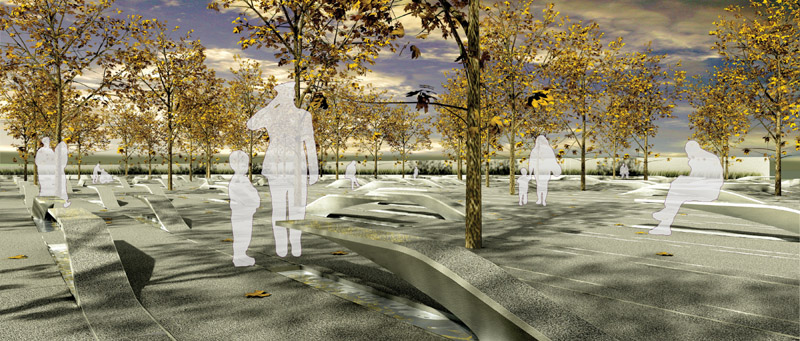Sept. 8, 2006 -- In March 2003, two young architects from New York, Julie Beckman and Keith Kaseman, won a worldwide competition to design a memorial to commemorate the 184 people killed when hijackers slammed an airplane into the Pentagon on Sept. 11, 2001.
Soon after winning the competition that attracted 1,126 entries, the architects contacted Robert G. Kelly and Edgar A. Starke Jr., two professors of materials science and engineering at the University of Virginia. The architects sought advice on the best material to use for their memorial.
The memorial will consist of 184 simple, streamlined metal benches — one for each of the people killed during the terrorist attack — cantilevered over lighted reflecting pools. The benches will be oriented differently, depending on whether the victim was in the building or on the plane. Behind the benches of those killed in the building, visitors will see the Pentagon; behind the benches of those killed in the plane, visitors will see the sky.
“They wanted to use aluminum for the memorial units for each of the victims,” Kelly said. “But aluminum alloys are not the best materials to use because they’re not particularly resistant to corrosion.”
The environment surrounding the memorial has more than its share of corrosive elements — deicing salts from nearby highways, gases from vehicle emissions and a saltwater tidal basin. Also, the memorial design calls for a highly reflective surface on the metal benches, which is difficult to achieve and maintain with aluminum.
Kelly, whose expertise is in corrosion, began to look for a stainless steel alloy that would meet the needs of the architects — corrosion resistance, high reflectivity — while remaining affordable and easy to work with.
After five castings of sample benches using different steel alloys at a foundry in St. Louis, Mo., Kelly believes the project team is closing in on a stainless steel alloy that will work. A commercially available product — SS 316LN, an austenitic stainless steel — is a likely candidate. It is a stainless steel that, along with iron, is composed of chromium (18 percent), nickel (12 percent), molybdenum (2.5 percent) and nitrogen (0.13 percent).
“The steel is about two and a half times more expensive than aluminum, but it will resist corrosion much better and cost less to maintain,” Kelly said. “The design goal for the memorial is to last 100 years.”
About $10 million has been raised for the memorial, which is expected to cost about $22 million. Organizers plan to raise an additional $10 million to ensure the memorial’s maintenance. The federal government has contributed about $1 million to the project, which is being funded primarily by private donors. Kelly provided his services on a pro-bono basis.
Soon after winning the competition that attracted 1,126 entries, the architects contacted Robert G. Kelly and Edgar A. Starke Jr., two professors of materials science and engineering at the University of Virginia. The architects sought advice on the best material to use for their memorial.
The memorial will consist of 184 simple, streamlined metal benches — one for each of the people killed during the terrorist attack — cantilevered over lighted reflecting pools. The benches will be oriented differently, depending on whether the victim was in the building or on the plane. Behind the benches of those killed in the building, visitors will see the Pentagon; behind the benches of those killed in the plane, visitors will see the sky.
“They wanted to use aluminum for the memorial units for each of the victims,” Kelly said. “But aluminum alloys are not the best materials to use because they’re not particularly resistant to corrosion.”
The environment surrounding the memorial has more than its share of corrosive elements — deicing salts from nearby highways, gases from vehicle emissions and a saltwater tidal basin. Also, the memorial design calls for a highly reflective surface on the metal benches, which is difficult to achieve and maintain with aluminum.
Kelly, whose expertise is in corrosion, began to look for a stainless steel alloy that would meet the needs of the architects — corrosion resistance, high reflectivity — while remaining affordable and easy to work with.
After five castings of sample benches using different steel alloys at a foundry in St. Louis, Mo., Kelly believes the project team is closing in on a stainless steel alloy that will work. A commercially available product — SS 316LN, an austenitic stainless steel — is a likely candidate. It is a stainless steel that, along with iron, is composed of chromium (18 percent), nickel (12 percent), molybdenum (2.5 percent) and nitrogen (0.13 percent).
“The steel is about two and a half times more expensive than aluminum, but it will resist corrosion much better and cost less to maintain,” Kelly said. “The design goal for the memorial is to last 100 years.”
About $10 million has been raised for the memorial, which is expected to cost about $22 million. Organizers plan to raise an additional $10 million to ensure the memorial’s maintenance. The federal government has contributed about $1 million to the project, which is being funded primarily by private donors. Kelly provided his services on a pro-bono basis.
Media Contact
Article Information
September 8, 2006
/content/uva-professor-lends-expertise-pentagon-911-memorial

